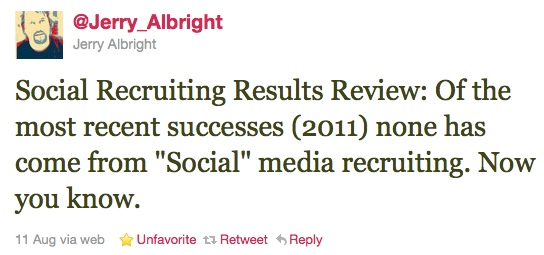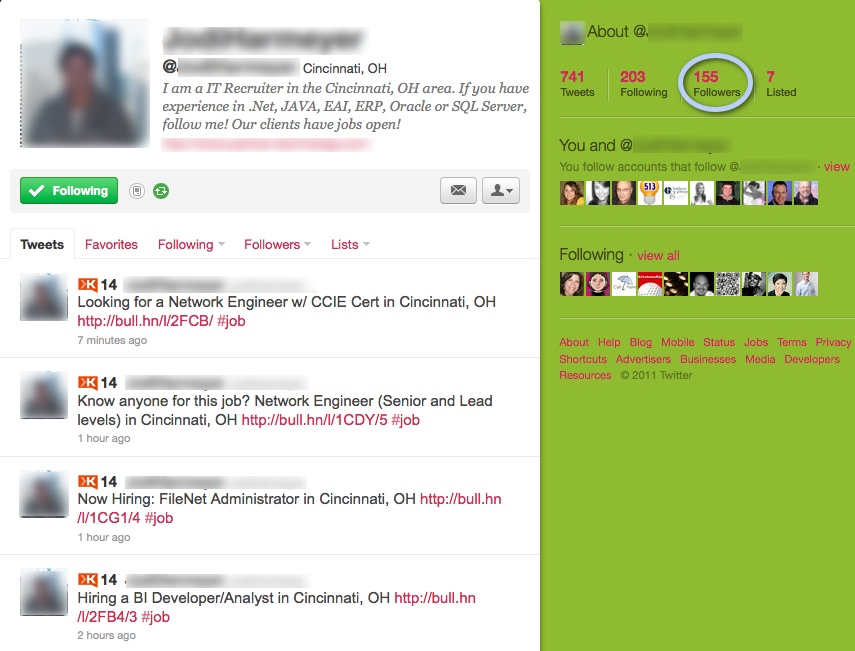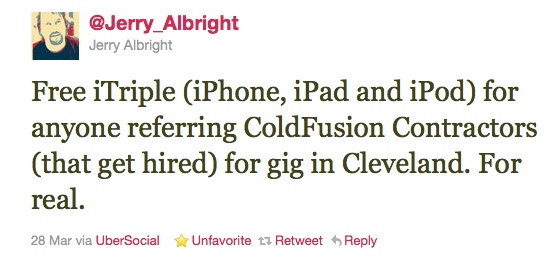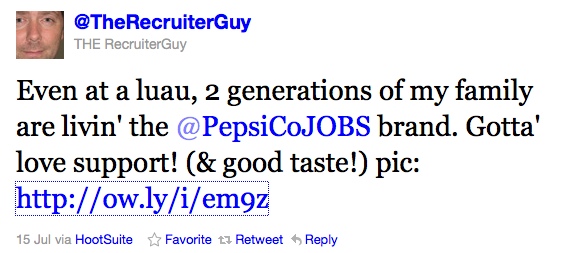When I signed up for Twitter in March 2008, I was a working as a busy Executive Recruiter and always seeking new ways to brand myself and the business I worked for, as well as ways to identify potential candidates. In those early days, I spent quite a bit of time learning how to connect, to build relationships and to find business benefits for the time that I spent online and on Twitter.
One of the biggest benefits I found was building an awareness of top talent in my local area – and worldwide – that I could consider for opportunities with my clients and “meeting” many awesome people that I believe I would never have come across through other channels – referrals included. As a result of building rapport and familiarity via Twitter, I was often able to reach out to my connections if there was an opportunity that I felt may be of interest or that they may know someone whom they’d like to refer – and they were more than willing to help. Personally, I never really used Twitter as a candidate sourcing method, although there are plenty of effective ways to use Twitter to identify talent to recruit.
Now, as a speaker, trainer and consultant working with companies and individuals on how best to use Twitter and other methods for recruiting top talent, I’m always on the lookout for best practices – and I’ve also come across quite a few “not so best practices” as well.
Below are five examples of “what not to do” on Twitter as a Recruiter.
1. Posting only job links
The best way to find the least value from Twitter as a Recruiter is to post only links to the jobs that you’re recruiting for. Why? Because just as no one would want to spend time talking with a Recruiter at a networking event who only spouted job links, they also don’t want to “talk” to them on Twitter.
Twitter is about engaging in conversation and adding value. Recruiters who only post job links typically have very few Followers and the visibility for all of those links they’re sharing is practically nil. These Recruiters are often the first to say “Twitter doesn’t work for recruiting”. At least not the way they’re doing it.
2. Protecting Tweets
Nothing says “I’m looking to build some mutually beneficial business relationships” like not trusting others with the information you share. Twitter is designed to be most effective when you’re able to access and participate in the larger conversation. Personally, I don’t follow accounts with protected tweets and they typically have very few Followers. Why? Because they’re doin’ it wrong.
3. Incomplete Bio/No Profile Photo/No Website Link
Want people to follow you on Twitter? Give them a reason to do so. You’ve got 160 characters to build interest, include keywords and share a bit about yourself. People make Follow decisions quickly on Twitter. If you’re not interesting or inviting, they’ll likely not connect. And for gosh sakes, give them a way to find out more about you/your company with a link to your careers page, company website or at least your LinkedIn profile. The Recruiter below is asking job seekers to get in touch with him, but provides no way to do so. My guess is – they’re not.
4. Engaging and Interacting Primarily With Other Recruiters
Many Recruiters who’ve given Twitter a shot and feel it’s not worth it may have joined and connected only with a few friends (other Recruiters) – and never really sought out or developed a following among people in the industries or professions in which they recruit. While Twitter can be helpful for finding other Recruiters for split opportunities (3rd party Recruiters), you won’t be able to find fish unless you fish where the fish are.
For example, take my favorite “anti-social” Recruiter – Jerry Albright. Jerry has long been a super successful Recruiter, but he regularly touts the lack of benefits he sees from Twitter.



 5. NOT Talking About What You Had For Lunch
5. NOT Talking About What You Had For Lunch
I recently attended a Recruiting Conference where the VP of Talent Acquisition at a local Fortune 200 company mentioned that his company was not using Twitter as a part of their recruiting strategy because “we don’t want our recruiters tweeting about what they had for lunch”. While I would certainly agree that Recruiters (and other employees) need training and guidance on how to best represent themselves and their companies on Twitter, I think this VP has missed the point of Twitter. Being a “whole person” on Twitter and sharing hobbies, interests, photos and tidbits from daily life makes for a more interesting person to follow and can position a Recruiter to share job openings and company information with a broader community of Followers.
For example, Chris Hoyt – Talent Engagement & Marketing Leader at PepsiCo. – classifies himself as a “life streamer” and has built quite a following by sharing interesting and funny tweets from his work, family and personal life along with regular mentions of the brands that he works with and the jobs his team is recruiting for.
In summary, to make this “Using Twitter For Recruiting” thing work, DO the following:
- Engage and add value with your tweets.
- Take advantage of the ability to build your network – by allowing people to connect with and follow you.
- Provide good information in your Bio to encourage Followers and include an appropriate link to learn more about you/your company.
- Follow and engage with people in the professions and industries that you recruit for – in addition to friends and professional peers.
- Be yourself. People want to follow real people – not auto-tweeters or corporate robots.






